| |
|
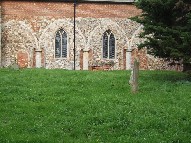 |
|
Bawdsey is the end
of the line, whichever way you look at
it. And there are essentially two ways of
looking at it; most famously, from
Felixstowe Ferry, on the far bank of the
Deben, where walkers and weekend sailors
sit outside the pubs gazing across to the
pine forests and heathland of the Bawdsey
Peninsula. The amazing Bawdsey Manor, a
Victorian confection of Elizabethanisms,
faces back, and was where radar was
developed. Today it is a language school.
You see it as you walk from Old
Felixstowe, past the martello towers and
the golf course. Or, you can look at Bawdsey
from the peninsula itself, where two
lonely roads come together at Alderton,
and thread through to the Manor, where
they stop. In medieval times, Bawdsey was
part of the Kingshaven, a group of
harbours around the mouth of the
Deben.Then, Bawdsey was on an island, a
causeway connecting it to the mainland.
|
But the sea has cut in over
the last 500 years, the Deben has silted up and
changed course dramatically, and only Bawdsey is
left, beached on the Suffolk coast. Actually, the
village is barely separated from Alderton, and
below are fine views of the sea and two more
martello towers. The whole place is riddled with
machine gun emplacements and WWII defences. But
Bawdsey is not only the place where radar was
developed; it is where two national heroes who
never actually lived here are immortalised, where
a great Suffolk church has been reduced to a
stump and chapel, where Guy Fawkes is responsible
for a Victorian restoration, and where you'll
find one of the most singular post-boxes in the
world.
Bawdsey's story pivots
around a man called William Cuthbert Quilter,
whose family had amassed a fortune. They rented
Hintlesham Hall in Suffolk for ten years in the
1880s, and then bought, at auction, the manordom
of Bawdsey. As Lord, he built Bawdsey Manor
between 1886 and 1910. Sir Cuthbert (as he now
was) had been MP for Ipswich since the 1880s. He
was, apparently, a man obsessed by real ale, and
the only time he stood up in the house to speak
it was on the subject of the purity of beer. He
built up a number of independent Suffolk
breweries, which, in the 1950s, were conveniently
bought up lock, stock and barrel by the Cobbolds,
who not unnaturally closed them all down.
Sir Cuthbert had such a high opinion of himself
and his family that he built an amazing mausoleum
in Bawdsey churchyard. You step out of the west
door of the church, and climb some steps to a
vast chest tomb, with family names on it. Beyond
that, more steps rise to an urn. I am sure that
if an eternal flame had been possible in the
1920s, he would have had one of those,
too. His family's names are inscribed
on it. This is interesting, because one of his
sons grew up to be the composer Roger Quilter,
one of the finest songwriters of the early 20th
century, and who, along with Peter Warlock, was
part of that English generation before Benjamin
Britten. But Roger Quilter wasn't born in
Suffolk, and he never lived in Bawdsey.
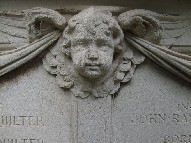 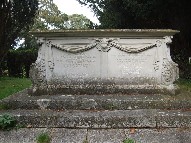 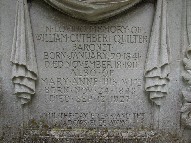
Funnily enough, the church
contains another memory of an even more famous
person, who not only wasn't born in Suffolk and
never lived here, she isn't buried here either.
This is Nurse Edith Cavell, shot in Belgium in
1916. The memorial to her great-uncle and
great-aunt remembers her as well, with a framed
account of her story hanging below their simple
wall plaque.
The remains of the medieval church are set in the
17th century walls. The arcades were filled in
with flint and brick, and the clerestorey broken
down and replaced by a brick course. The whole
lot was then rendered (now removed, fortunately).
The church was a grand perpendicular affair, in
the manner of Blythburgh, Covehithe or Southwold.
However, like Covehithe, it was derelicted after
the Reformation, and a new, smaller church built
in the ruins, probably in the late 17th century.
Remarkably, the former arcades were infilled for
the walls, and you can still see them in the
outside walls today. The tower was in danger of
collapse, and in the 1820s, the tiles of the
church roof were replaced by thatch, to stop bits
of stone breaking the tiles (it is hard to think
of this as anything other than a short term
measure.) Unfortunately, when a group of
youths set off fireworks from the top of the
tower on Guy Fawkes Night 1841, the thatch caught
fire, and the church was completely gutted. A
warning, I suppose, against the perils of
Protestant triumphalism. The rebuilt church is
basically a Victorian chapel with 17th century
walls, a truncated tower (about two thirds was
removed), an unusual font, and a pulpit unique to
Suffolk..
Although this little church is interesting and
welcoming, it can be a bit gloomy inside if the
sun isn't shining, thanks to the small windows.
The font is a most curious 18th century affair,
tapering narrowly and then opening out, and
resembling nothing so much as a bird bath. It
goes most harmoniously with the Quilter memorial
outside, and may well date from a reordering of
the church under Sir Cuthbert's influence in the
1890s. The pulpit consists of a frame of
banisters, and probably dates from the 1890s,
although some early 20th century photographs show
it faced, without the banisters visible. The
church also contains on display a piece of
medieval embroidery, possibly from a cope, that
was worked in the 19th century into an altar
frontal. It is believed to have come from the
chapel at Bawdsey Manor, and may have been
collected by the Quilters in Belgium.
Unsurprisingly,
the church has a special place in its
heart for the RAF, who were based at
Bawdsey manor during the Second World War
and for a number of years afterwards. The
Union flag and RAF banner in the chancel
make it feel rather crowded, I fear.
However, the setting for the church is
lovely, and surprisingly rural, given
that we are on the main village street.
On one occasion, while trying to
photograph the Quilter memorial, a deer
broke cover beneath my feet, and ran for
the woods. I nearly died.
And the post box? Well, a bit further
along the road to Alderton, the former
post office still has in its wall one of
the last surviving Edward VIII
wall-mounted letter boxes in the world. |
|
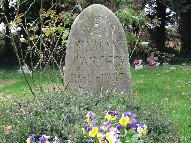 |
|
|
|

